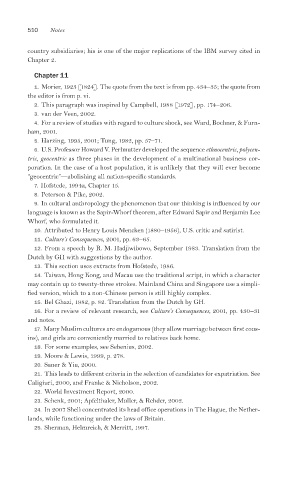Page 545 - Cultures and Organizations
P. 545
510 Notes
country subsidiaries; his is one of the major replications of the IBM survey cited in
Chapter 2.
Chapter 11
1. Morier, 1923 [1824]. The quote from the text is from pp. 434–35; the quote from
the editor is from p. vi.
2. This paragraph was inspired by Campbell, 1988 [1972], pp. 174–206.
3. van der Veen, 2002.
4. For a review of studies with regard to culture shock, see Ward, Bochner, & Furn-
ham, 2001.
5. Harzing, 1995, 2001; Tung, 1982, pp. 57–71.
6. U.S. Professor Howard V. Perlmutter developed the sequence ethnocentric, polycen-
tric, geocentric as three phases in the development of a multinational business cor-
poration. In the case of a host population, it is unlikely that they will ever become
“geocentric”—abolishing all nation-specifi c standards.
7. Hofstede, 1994a, Chapter 15.
8. Peterson & Pike, 2002.
9. In cultural anthropology the phenomenon that our thinking is influenced by our
language is known as the Sapir-Whorf theorem, after Edward Sapir and Benjamin Lee
Whorf, who formulated it.
10. Attributed to Henry Louis Mencken (1880–1956), U.S. critic and satirist.
11. Culture’s Consequences, 2001, pp. 63–65.
12. From a speech by R. M. Hadjiwibowo, September 1983. Translation from the
Dutch by GH with suggestions by the author.
13. This section uses extracts from Hofstede, 1986.
14. Taiwan, Hong Kong, and Macau use the traditional script, in which a character
may contain up to twenty-three strokes. Mainland China and Singapore use a simpli-
fied version, which to a non-Chinese person is still highly complex.
15. Bel Ghazi, 1982, p. 82. Translation from the Dutch by GH.
16. For a review of relevant research, see Culture’s Consequences, 2001, pp. 430–31
and notes.
17. Many Muslim cultures are endogamous (they allow marriage between fi rst cous-
ins), and girls are conveniently married to relatives back home.
18. For some examples, see Sebenius, 2002.
19. Moore & Lewis, 1999, p. 278.
20. Saner & Yiu, 2000.
21. This leads to different criteria in the selection of candidates for expatriation. See
Caligiuri, 2000, and Franke & Nicholson, 2002.
22. World Investment Report, 2000.
23. Schenk, 2001; Apfelthaler, Muller, & Rehder, 2002.
24. In 2007 Shell concentrated its head office operations in The Hague, the Nether-
lands, while functioning under the laws of Britain.
25. Sherman, Helmreich, & Merritt, 1997.

